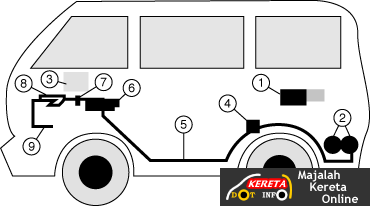
1. Natural gas is compressed and enters the vehicle through the natural gas fill valve (receptacle).
2. It flows into high-pressure cylinders located in or under the vehicle.
3. In a bi-fuel NGV, a fuel selector on the dash permits selection of natural gas or gasoline. A dedicated NGV operates solely on natural gas.
4. When natural gas is needed by the engine, it leaves the cylinders and passes through the master manual shut-off valve.
5. The gas goes through the high-pressure fuel line and enters the engine compartment.
6. Gas enters the regulator, which reduces pressure from up to 3,600 psi to near atmospheric pressure.
7. The natural gas solenoid valve allows natural gas to pass from the regulator into the gas mixer or natural gas fuel injectors. (Or, it shuts off the natural gas when the engine is not running or when, in the case of a bi-fuel vehicle, gasoline is selected).
8. In a bi-fuel NGV, natural gas mixed with air flows down through the gasoline carburetor or fuel injection system and enters the engine’s combustion chambers. In a dedicated NGV, natural gas is injected into the engine’s combustion chamber via specially designed natural gas fuel injectors.
9. In a bi-fuel NGV, when the driver selects gasoline, the conventional gasoline system is activated and the natural gas system is automatically shut off.



Jom komen!